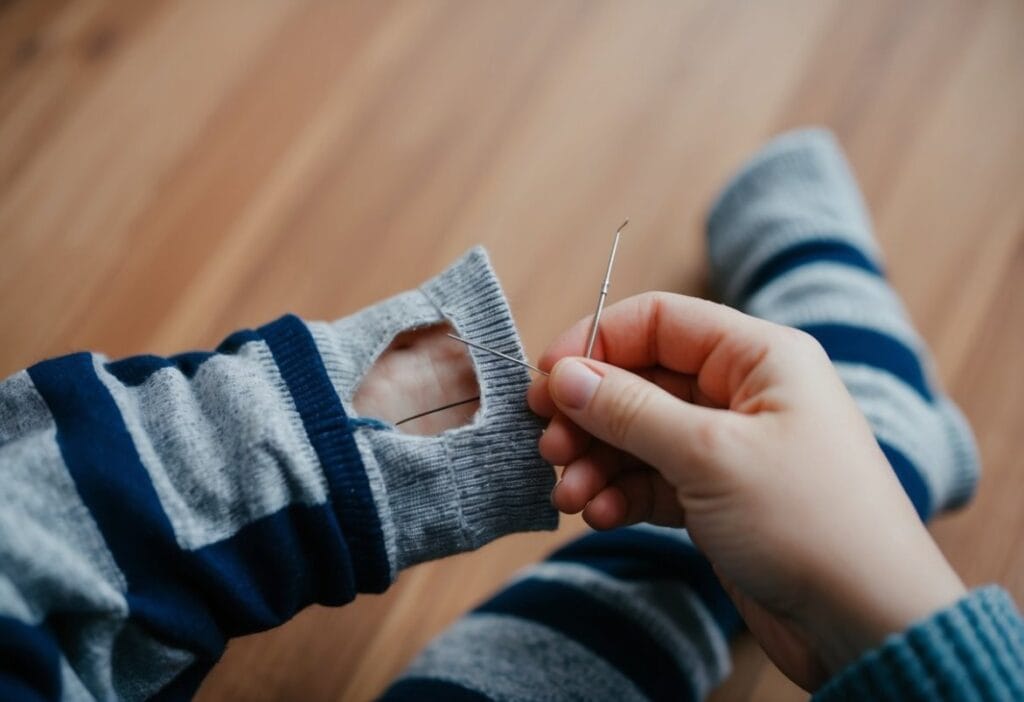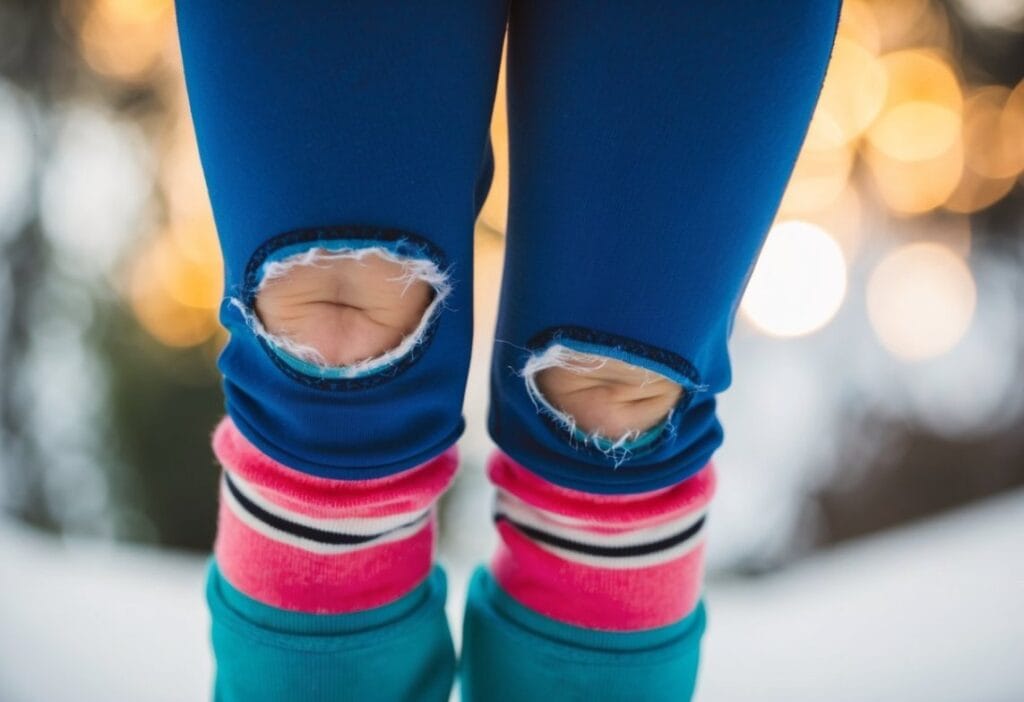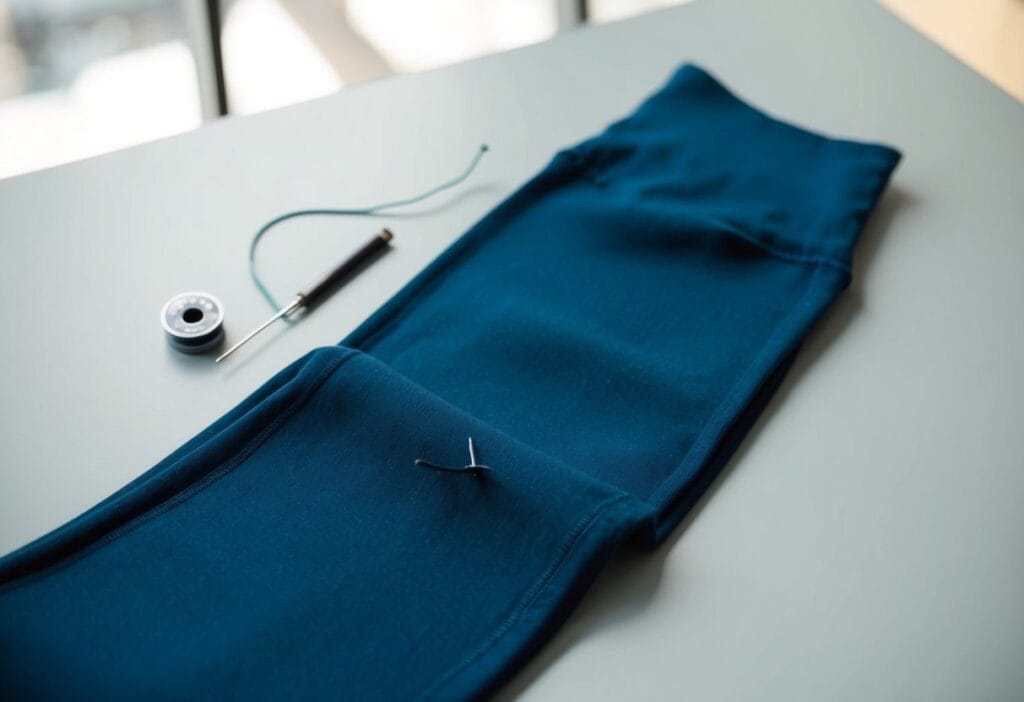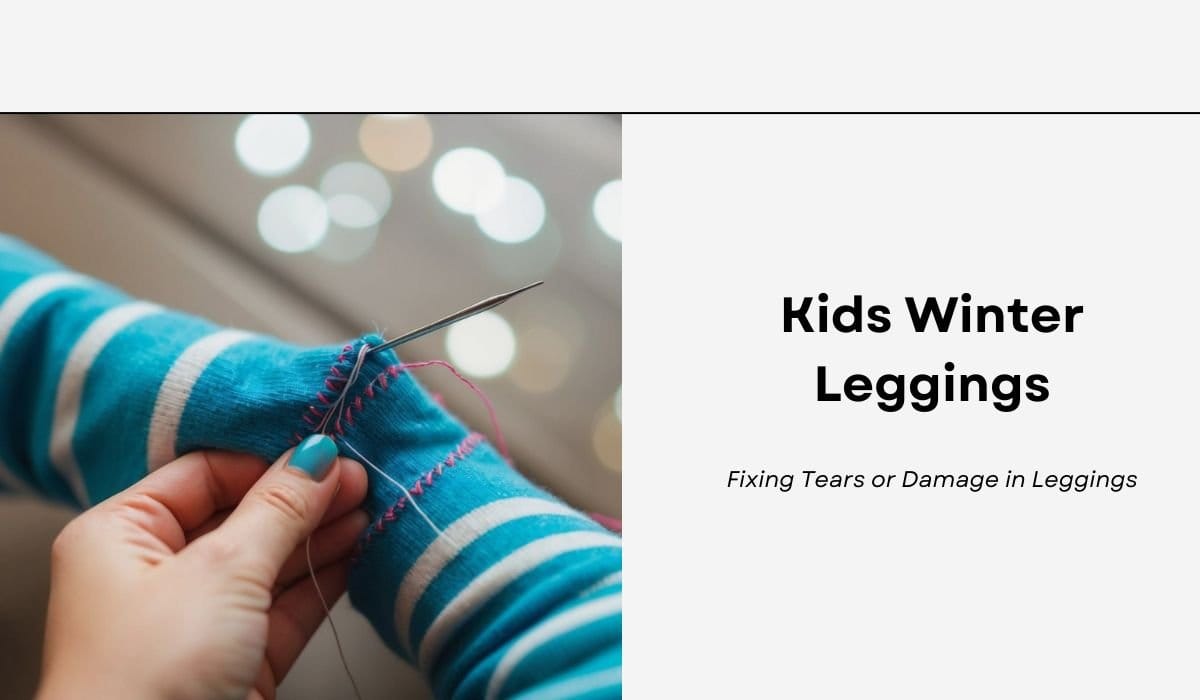Rescue Your Child’s Favorite Winter Wear: Quick Fixes and Long-Term Solutions for Damaged Leggings
Kids’ winter leggings are a cosy staple for chilly days, but they can sometimes get tears or damage from active play. Fixing these issues is often simpler than you might think. With a few basic sewing skills and the right materials, you can easily mend small holes or tears in your child’s favourite leggings.
Winter leggings come in various types, including thermal options for extra warmth and styles with reinforced knees to prevent wear and tear. When shopping for kids’ leggings, look for sturdy materials that can withstand rough-and-tumble activities. If you spot a small hole or torn seam, don’t bin the leggings just yet – a quick repair can extend their life and save you money.
Repairing leggings at home is a practical skill that can help keep your little ones warm and comfortable all winter long. By learning some simple mending techniques, you can tackle common issues like small holes, loose threads, or split seams. This not only saves your wallet but also teaches children about sustainability and the value of taking care of their clothes.
On This Page
Key Takeaways
- Basic sewing skills can fix most legging tears and holes at home
- Choose sturdy winter leggings with features like thermal lining and reinforced knees
- Regular mending extends the life of leggings and promotes sustainable clothing habits
Understanding the Importance of Quality Winter Leggings for Kids

Quality winter leggings are a key part of keeping children warm and cosy in cold weather. They act as a base layer, providing insulation against chilly temperatures.
Thermal leggings made from special fabrics help trap body heat close to the skin. This keeps kids’ legs toasty even when playing outside on frosty days.
Good winter leggings should be:
- Soft and comfortable
- Stretchy for easy movement
- Durable to withstand active play
- Moisture-wicking to keep skin dry
Thermal underwear like leggings is especially important for young children. Their small bodies lose heat more quickly than adults, so they need extra protection.
Layering is crucial for winter warmth. Quality leggings provide an excellent foundation under trousers or skirts. They add warmth without bulk, allowing kids to move freely.
For outdoor activities, thermal leggings are a must-have. They keep legs warm during sledging, skating or building snowmen. Indoor play benefits too, as leggings maintain cosiness on cold floors.
Investing in well-made winter leggings pays off. They last longer and provide better insulation than cheaper options. This means fewer replacements and warmer, happier kids all winter long.
Types of Winter Leggings for Children
Winter leggings for kids come in various styles to suit different needs and preferences. These options provide warmth, comfort, and durability for active children during cold weather.
Thermal Leggings: A Versatile Choice
Thermal leggings are a popular choice for children in winter. They’re made with special fabrics that trap heat close to the body. This keeps kids warm without adding bulk.
Many thermal leggings have a soft, brushed interior. This feels cosy against the skin. Some are made with moisture-wicking materials. These help keep children dry during active play.
Thermal leggings come in different weights. Lighter ones are good for mild days. Heavier versions work well in very cold weather. They can be worn on their own or under trousers for extra warmth.
Treggings and Joggers: Comfort Meets Style
Treggings are a mix of trousers and leggings. They’re thicker than regular leggings but more stretchy than trousers. This makes them comfy and warm for winter wear.
Treggings often have faux pockets and waistbands. This gives them a smart look. They’re great for school or casual outings.
Joggers are another cosy option. They’re made from soft, warm fabrics like fleece. Many have ribbed cuffs at the ankles. This helps keep out cold air. Joggers are perfect for active play or lounging at home.
Leggings with Reinforced Knees for Active Kids
Some winter leggings have extra fabric or padding on the knees. This makes them more durable. It’s ideal for children who like to crawl, climb, or play rough.
Reinforced knees help prevent tears and holes. This means the leggings last longer. It also keeps kids’ knees warm when they’re on the ground.
These leggings often use tough fabrics like cordura. Some have removable knee pads. This adds protection for activities like skating or cycling.
Identifying Common Issues in Kids’ Winter Leggings

Kids’ winter leggings face unique challenges due to active play and harsh weather. Spotting problems early helps extend their lifespan and keeps children warm and cosy.
Wear and Tear: From Thinning to Holes
Knees and seat areas often thin first in kids’ leggings. Look for shiny patches or pilling, which can lead to holes. Check seams regularly, as they may come undone from stretching.
Rough play can cause snags or pulls in the fabric. These can turn into larger holes if left unchecked. Inspect leggings after outdoor activities for any new damage.
Friction from boots or wellies can wear down ankles and hems. Watch for fraying edges or loose threads in these spots.
Colour Fading: Managing White and Dark Grey Fabrics
White leggings may turn dingy or grey over time. This is common in areas that touch shoes or the ground. Stains from grass or mud can be tough to remove completely.
Dark grey leggings often fade unevenly. Knees and bottoms might lighten faster than other parts. Sun exposure can speed up fading, even in winter.
Washing can cause colour loss. Check care labels and use cold water when possible. Turn leggings inside out before washing to protect the outer surface.
Some fabrics pill more easily, creating a fuzzy look. This is especially noticeable on darker colours like grey. Gentle washing and air-drying can help reduce pilling.
Step-by-Step Guide to Repairing Leggings

Turn the leggings inside out. This makes it easier to see and fix the damage.
Examine the tear closely. Small holes can be mended with a simple stitch, while larger ones may need a patch.
For minor holes, thread a needle with matching thread. Tie a knot at the end.
Start sewing about 1 cm away from the hole. Use small, even stitches to close the gap.
For bigger tears, cut a patch from similar fabric. Make it slightly larger than the hole.
Pin the patch in place over the damaged area. Sew around the edges with a zigzag stitch.
To reinforce knees, iron on patches to the inside of the leggings. This adds strength to high-wear areas.
For a no-sew option, apply fabric glue to seal small tears. Let it dry completely before wearing.
Test the repair by gently stretching the fabric. Make sure it moves with the leggings.
Trim any loose threads. Turn the leggings right side out and check your handiwork.
These fixes can greatly improve the life of kids’ winter leggings. With proper care, repaired leggings can withstand plenty of playtime.
Choosing the Right Materials for Leggings Repair
Selecting proper materials is key for fixing kids’ winter leggings. The right supplies ensure repairs last and keep little ones warm.
For thermal leggings, use stretchy fabric patches that match the thickness. Look for fleece-lined or insulated patches to maintain warmth. Reinforced knees need extra-durable materials.
Essential repair items:
- Stretchy fabric (matching colour and weight)
- Thread to match leggings
- Sewing needle or machine
- Scissors
- Iron-on patches (for quick fixes)
- Fabric glue (for small holes)
Choose thread that matches the leggings’ colour and stretchiness. Polyester thread works well for most repairs.
For hand sewing, pick a needle suited for knit fabrics. A ballpoint or stretch needle prevents damage to the leggings’ fibres.
Iron-on patches offer a fast solution for small tears. Select patches made for stretchy fabrics to allow movement.
Fabric glue can mend tiny holes quickly. Use a flexible, washable glue meant for clothing repairs.
With the right tools, fixing kids’ winter leggings becomes simple. Proper materials help ensure repairs stand up to active play and cold weather.
Best Practices for Maintaining Leggings’ Longevity
Proper care is key to keeping kids’ winter leggings in top shape. Wash leggings in cold water to prevent shrinkage and maintain elasticity. Turn them inside out before washing to protect the outer fabric.
Avoid using harsh detergents or fabric softeners. These can break down the fibres over time. Instead, opt for mild, gentle cleaners made for activewear.
Air-drying is best for thermal leggings. If you must use a dryer, choose a low heat setting. High heat can damage elastic and reduce the insulating properties of thermal fabrics.
Store leggings folded neatly in a drawer. Don’t hang them, as this can stretch out the waistband and knees.
Trim loose threads promptly to prevent snags from worsening. For small holes, use a fabric patch on the inside of the legging for reinforcement.
Rotate between multiple pairs of leggings. This gives each pair time to rest between wears, helping the elastic recover its shape.
Consider improvements like reinforced knees for active kids. Some brands offer leggings with extra durable patches in high-wear areas.
Teach children to be mindful of rough surfaces that could snag or tear their leggings. Proper wear habits can greatly extend the life of their winter gear.
The Role of Leggings as a Base Layer
Leggings play a crucial part as a base layer in cold weather. They sit close to the skin and trap warmth, keeping children cosy when temperatures drop.
As a base layer, leggings act like thermal underwear. They provide insulation without adding bulk, allowing kids to move freely during winter activities.
Many leggings designed for cold weather are made from special fabrics. These materials wick moisture away from the skin, keeping children dry and comfortable.
Base layer leggings come in different weights. Lightweight options work well for mild cold, while thicker versions offer more warmth in frigid conditions.
Some popular materials for base layer leggings include:
- Merino wool
- Synthetic blends
- Silk
Parents often choose merino wool leggings as a base layer. This natural fibre regulates body temperature and resists odours, making it ideal for active children.
Synthetic base layers dry quickly and are often more affordable. They work well for high-energy activities where kids might sweat more.
When selecting base layer leggings, a snug fit is key. This ensures the leggings trap heat effectively and don’t bunch up under other clothing layers.
Integrating Leggings into Varied Winter Outfits
Leggings are a versatile wardrobe staple for kids during cold months. They can be paired with various items to create cosy winter outfits for different occasions.
For everyday wear, kids can match leggings with a long jumper or tunic. Add warm socks and ankle boots to complete the look. This combination provides comfort for school or playtime.
On colder days, layer leggings under a skirt or dress. Thick tights or thermal underwear can be worn underneath for extra warmth. Top with a cardigan or jacket for a stylish yet snug outfit.
For outdoor activities, pair leggings with a waterproof jacket and wellies. A fleece mid-layer adds insulation without bulk. This ensemble keeps children dry and warm during winter adventures.
Sporty kids can wear leggings with a hoodie and trainers. This athletic look is perfect for PE lessons or casual outings. Choose thermal or fleece-lined leggings for added cosiness.
Dressing up leggings is simple. Pair them with a sparkly top and ballet flats for parties. A denim jacket adds a cool touch to this outfit.
Quick Outfit Ideas:
- Leggings + oversized jumper + boots
- Leggings + dress + cardigan
- Leggings + t-shirt + zip-up hoodie
By mixing and matching these pieces, children can stay warm and stylish throughout the winter season.
Navigating Online Shopping for Kids’ Leggings
Online shopping for kids’ winter leggings offers many options. Parents can find great deals and styles from the comfort of home.
Optimising Your Shopping Experience on Amazon Stores
Amazon provides a wide selection of kids’ winter leggings. Use filters to narrow down choices by size, colour, and price. Read customer reviews for helpful insights on fit and quality. Look for Prime-eligible items to get fast, free delivery.
Check the product description for details on materials. Fleece-lined leggings are great for extra warmth. Some leggings come in multi-packs, offering good value.
Create a wishlist to save favourites for later. This makes it easy to compare options or wait for sales. Sign up for Amazon’s email alerts to get notified of price drops on items you’re watching.
Understanding How Cookies and Device Information Are Used
Websites use cookies to remember your preferences and browsing history. This helps tailor your shopping experience. You might see ads for kids’ leggings you’ve looked at before.
Device information helps sites adjust to your screen size. This ensures the shopping pages look good whether you’re on a mobile or computer.
Some sites use this data to offer location-based deals or stock information. You can manage cookie settings in your browser for more control over data use.
Be aware that clearing cookies may reset your shopping cart on some sites. It’s a good idea to create an account to save your details securely.
Privacy and Advertising: How They Affect Your Choices
Privacy and advertising play key roles in shaping your online experience. They impact the content you see and how companies interact with you.
Analysing Personalised Ads and Audience Insights
Personalised ads use data about your online activities to show you targeted content. Companies track your browsing habits, searches, and purchases to build a profile of your interests.
This profile helps advertisers show you ads they think you’ll like. It also gives them audience insights – information about groups of users with similar traits.
A unique identifier, like a cookie or device ID, links your activity across websites and apps. This lets advertisers follow your digital footprint and tailor their messages.
Some people find personalised ads helpful for discovering relevant products. Others worry about the amount of personal data being collected and shared.
Making Informed Advertising Choices and Understanding Privacy Notices
You have options to control how your data is used for advertising. Many websites and apps let you opt out of personalised ads or limit data collection.
Privacy notices explain how companies gather and use your information. They detail what data is collected, who it’s shared with, and how it’s protected.
Reading privacy notices helps you make informed choices about your data. Look for clear explanations of:
- What information is collected
- How it’s used for advertising
- Who has access to your data
- Your rights to control or delete your information
Consider using privacy tools like ad blockers or VPNs to reduce tracking. Be aware that some sites may not work properly if you block all ads or tracking.
Evaluating the Impact of Site Visits on Product Improvements
Site visits play a crucial role in assessing and enhancing product quality. They allow companies to gather first-hand information about how their products perform in real-world settings.
During site visits, evaluators can observe products in use and speak directly with users. This provides valuable insights that may not be apparent through remote feedback channels.
Site visits can reveal issues with product implementation or usage that weren’t anticipated. For example, evaluators might discover that a winter legging fabric is wearing thin in unexpected areas.
Key benefits of site visits for product improvement:
• Direct observation of product performance • Immediate user feedback • Identification of unforeseen issues • Better understanding of usage contexts
To maximise the impact of site visits, companies should:
- Set clear objectives
- Choose diverse sites to visit
- Use skilled observers
- Document findings thoroughly
- Follow up promptly on insights gained
Site visits can lead to targeted improvements in product design, materials, or manufacturing processes. For instance, a legging manufacturer might adjust seam placement based on wear patterns observed during visits.
By conducting regular site visits, companies can stay responsive to user needs and maintain product quality. This hands-on approach helps ensure that improvements are based on real-world evidence rather than assumptions.
Frequently Asked Questions
Leggings can often develop tears or holes, especially in high-wear areas. Here are some common questions about fixing damaged leggings, with practical tips for repairs.
How can one mend a small hole in leggings without the need for sewing?
For small holes, fabric glue is a quick fix. Apply a thin layer around the hole’s edges and press them together. Let it dry fully before wearing. Another option is iron-on patches, which stick to the fabric when heated.
What is the best method to repair a tear along the inner thigh of leggings by hand?
To mend an inner thigh tear by hand, use a needle and thread that match the leggings’ colour. Stitch back and forth across the tear, keeping the stitches close together. For added strength, sew a small patch on the inside of the leggings.
Is it possible to fix a tear in children’s leggings, and if so, how?
Yes, tears in children’s leggings can be fixed. For small tears, use fabric glue or hand-sewing. For larger tears, iron-on patches work well. Choose fun, colourful patches to make the repair look intentional and appealing to kids.
What techniques are effective for repairing holes in the knee area of leggings?
Knee holes are common in leggings. Patch the area with a piece of stretchy fabric. Sew it on by hand or machine, using a zig-zag stitch for flexibility. For a no-sew option, use iron-on patches designed for stretchy fabrics.
Why are my leggings prone to tearing, and how might I prevent this?
Leggings tear due to friction, overstretching, or poor quality fabric. To prevent tears, buy high-quality leggings and wash them gently. Avoid wearing them for high-impact activities they’re not designed for. Rotate your leggings to reduce wear on each pair.
Can stretchy fabric patches be applied to leggings, and do they hold effectively?
Stretchy fabric patches can be applied to leggings and hold well if used correctly. Choose patches made for stretch fabrics. Apply them with fabric glue or by sewing, using a zig-zag stitch. These patches move with the leggings, making them less likely to peel off.
Related Post: How to Care for Kids’ Leggings and Bottoms: Essential Tips for Long-Lasting Wear

